- News
First Patient Enrolled! The World’s First Biodegradable Aortic Dissection Occluder FIM Clinical Trial Successfully Launched at Shanghai General Hospital
https://mp.weixin.qq.com/s/EavSsoHUp_TOxrhPR3cipA
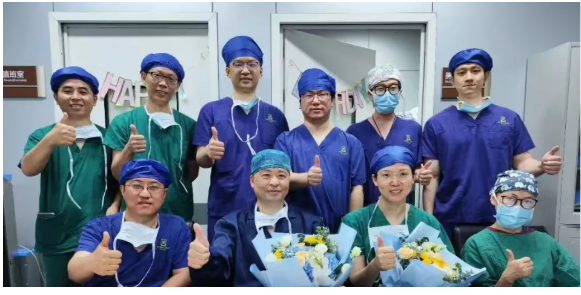
Team photo of the surgical operators
On June 12, 2025, the team led by Professor Rui Feng from the Interventional Center and Department of Vascular Surgery at Shanghai General Hospital successfully implanted a biodegradable aortic dissection occluder in a male patient with aortic dissection, sealing the rupture site. This marks the first case enrolled in the First-in-Man (FIM) clinical study of this China-developed biodegradable aortic occluder, achieving the world’s first innovative application of biodegradable technology in thoracic endovascular aortic repair (TEVAR) for aortic dissection. The success offers a promising “China solution” to address the long-standing global challenge of treating distal aortic dissection ruptures.
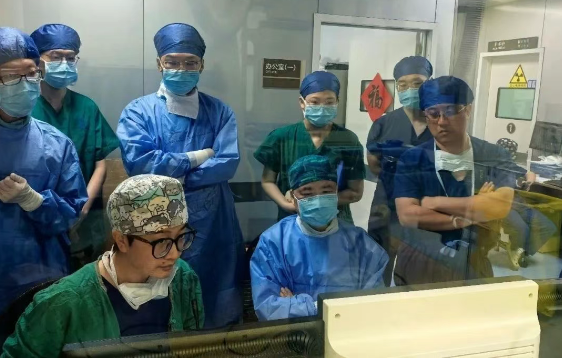
Intraoperative occluder deployment strategy discussion
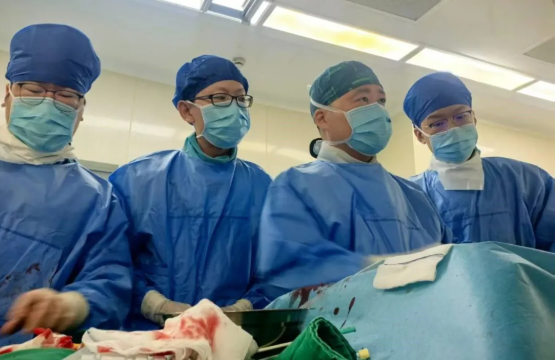
Device implantation in progress
This pioneering technology was originally proposed and developed by Professor Rui Feng of Shanghai General Hospital, who also serves as one of the lead investigators. He is spearheading the clinical evaluation of this novel device's safety and technical feasibility, steadily building clinical evidence to support the biodegradable occluder's use in treating distal aortic dissection rupture sites. The project represents a major breakthrough in tackling yet another "bottleneck" technology in China’s high-end medical device field.
Pioneering Innovation:
A New Generation Biodegradable Aortic Occluder for Endovascular Treatment of Aortic Dissection Ruptures
Following thoracic endovascular aortic repair (TEVAR), patients often experience post-dissection thoracoabdominal aneurysms. A major contributor to persistent false lumen blood flow is the residual distal rupture site. Compared to traditional endovascular techniques, this innovative approach using biodegradable occluders to seal dissection ruptures offers several clear advantages:
No need for visceral branch reconstruction, reducing surgical complexity
Preserves intercostal and lumbar arteries, lowering risk of paralysis
Reliable sealing, rapid and minimally invasive procedure
Fewer stent implants, complete degradation, restoring vascular elasticity
Case Overview: First Patient Enrolled
The patient, a 45-year-old male, was admitted to Shanghai General Hospital’s Department of Vascular Surgery on June 8, 2025, due to recurrent hemoptysis for two years following aortic dissection surgery seven years prior.
Medical history summary:
July 2018: Sudden onset of aortic dissection; underwent Bentall procedure, aortic arch replacement, and frozen elephant trunk technique
December 2023 & September 2024: Two separate TEVAR procedures for hemoptysis
June 2025: Continued high false lumen pressure and intermittent hemoptysis due to persistent distal rupture; further interventional treatment planned
Preoperative diagnosis:
Aortic dissection status post repair; hypertension
Surgical challenges:
The patient presented with a narrow true lumen, and the target rupture was located near the vessel edge. Selecting the appropriate implantation path and ensuring the occluder conformed to complex anatomy were key technical hurdles.
Surgical strategy:
CT imaging showed a narrow true lumen and a large false lumen. A sheath was introduced through the false lumen to access the rupture site, allowing occluder implantation. A pigtail catheter was placed in the true lumen for contrast observation.

Preoperative CT assessment

Establishing implant path and contrast imaging of rupture
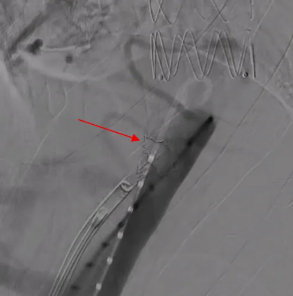
True lumen disc deployed and fitted against intima
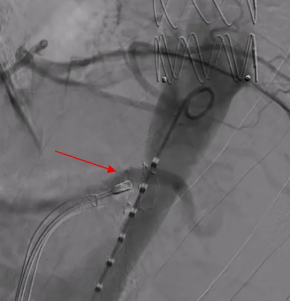
False lumen disc deployment

Final DSA showing no residual leak and stable occluder fixation
Postoperative Outcome and Summary
The surgery was performed by Professor Rui Feng's team using advanced minimally invasive techniques. After deploying the new biodegradable occluder, DSA imaging confirmed complete sealing with no residual leakage. The occluder adapted well to the patient’s anatomical structure, securely anchoring to the intima, maintaining unobstructed blood flow in the true lumen. The procedure was completed successfully, saving the patient's life and pioneering a new global standard for biodegradable occlusion in aortic dissection management.
This milestone represents a key achievement in Shanghai General Hospital's contribution to the “Healthy China 2030” strategy and showcases China’s growing capabilities in independent medical innovation.
Professor Rui Feng expressed optimism about the success of this first FIM case, and hopes that ongoing multicenter enrollment across the country will yield additional data to further validate the safety and efficacy of this novel therapy.
